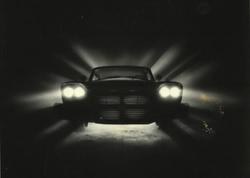« All Messed Up | Main | Collaboration and The Exquiste Corpse »
November 04, 2004
The Uncanny, Christine, and Frankenstein
Following Cameron's advice I've been looking into Freud's notion of the 'unheimlich' ñ which translates (apparently only "roughly"?) as the english 'uncanny' . . . which is itself kind of difficult to define. However this problem with definition, the indescribable, is apparently an integral part of our understanding of the uncanny experience . . . "which is terrifying precisely because it cannot be adequately explained" (from http://www.engl.virginia.edu/enec981/Group/chris.uncanny.html). The uncanny derives it's terror precisely through the collision of familiarity with the inability to describe or categorise the 'thing'. This relates to my recent seminar where I discussed familiarity/comfort, and the monstrous/grotesque as a potentially disrupting factor in design process . . . the transformation of the familiar.
The image here is of Christine, the car in the movie adaptation of Stephen King's book of the same name.
According to Freud the uncanny is evoked through the collapsing of psychic boundaries between self and other, life and death, reality and unreality . . .
1. Doubt . . . as to whether an animate object is really alive; or conversely, whether a lifeless object might not in fact be animate (Freud refers to Jentsch). So borders, categories, distinctions are blurred or questioned. Christine is car, an inanimate object, a machine that can do very little without human input. However Christine does 'seem' to be doing things of 'her' own choice . . . for quite a while we are uncertain as to whether the car is alive or not. This is when the uncanny effect it as it's height, when it taps into our uncertainty. Is Dr Frankenstein's monster really alive or still kind of dead? Like a Zombie. The living dead. (The guy in the supermarket the otherday had an uncanny resemblance to Elvis Presley . . . uncanny because Elvis is supposed to be dead, but we've all heard the conspiracy theories about him faking his own death . . . but also . . . )
2.The Double. The border between the self and the other is obfuscated by the appearance of the double. Freud references Otto Rank (1914) who has discussed connections between the 'double' with REFLECTIONS in mirrors, and SHADOWS. In Mary Shelly's 'Frankenstein', the monster functions as the scientist's baser self (Aija Ozolins), Dr Frankenstein is haunted by the double's presence. Is Christine actually acting out her driver's unconscious darker self? Did Elvis' dead twin live, in spirit, through him . . . hence the contradictions that made him who he was.
The uncanny and the failure of Frankenstein . . .
". . . the Shadow diminishes as one's awareness increases. 'Freedom comes,' according to Mahoney, 'not in eliminating the shadow . . . but in recognising him in yourself' . . . His rejection of his creature is crucial . . . Frankenstein, as Philmus says, is always 'fleeing from self-knowledge,' always seeking 'to lose himself in the external world' . . ."
(Aija Ozolins, 'Dreams and Doctrines: Dual Strands in Frankenstein'. From Science Fiction Studies 2, 1975: 103ñ110)
I thought maybe there was something here about recognising your mistakes?
It's interesting that Dr Frankenstein in the book flees from his monster and is horrified by it, quite a different reaction to the Dr Frankenstein of the early movie versions. I have to admit here that I haven't read Mary Shelly's book! I'll put this on my ever ballooning list of 'to reads'.
Posted by Luke Wood at November 4, 2004 09:09 AM
